Mushrooms and Toadstools: what’s the difference?
The two questions I get asked most often when guiding fungi forages are ‘Is this edible?’ and ‘What’s the difference between mushrooms and toadstools?’ I tend not to answer either directly.
In the case of the former, I encourage the asker to work out for themselves what species they are holding by observing its key features then answer the question for themselves. This may sound evasive, but its much more useful in the long run. The most satisfying foraging moments for any forager comes when they finally ‘crack’ a new species after years of searching and wondering. Its also important that we take personal responsibility for what we put in our mouths. And besides all that…I may not know anyway.
The second question is tricky because I have to second-guess what the asker means by ‘toadstool’. Sometimes they mean ‘any poisonous fungi’, others they mean ‘mushrooms that don’t look like field or cultivated mushrooms’. Occasionally they are wondering about the precise definitions like I am. The dictionary doesn’t help much:
Mushroom: a type of fungus, usually shaped like an umbrella, many of which are edible.
Toadstool: any of several mushroom-like fungus, some of which are poisonous.
Err…thanks…that really helps. The inference is, I suppose, that mushrooms tend to be edible and toadstools tend to be poisonous. This is no use at all for the forager who has to deal in certainties. And besides, I think the cultural distinction in the UK is more subtle.
“Oh, I only pick mushrooms. They are easy, we get them in the horse field. But I wouldn’t know about the toadstools that come up in the woods…”. I hear this sort of thing quite regularly. The inference here is that species that grow in fields (often with white caps and pink to chocolate coloured gills) are safe and edible, but the odd, brightly coloured stuff in the woods may be edible but should be treated with extreme caution. This is muddled thinking that will not only mean you miss out on the best edible species, but may give you a nasty tummy upset, land you in hospital, or worse.
Take a look at these three pictures. One is edible and delicious, one will give you a nasty tummy upset, and one will probably kill you. So which are toadstools and which are mushrooms?
The answer is they are all both and neither…
Left is the yellow stainer, which is unpleasantly poisonous, and virtually indistinguishable from horse and field mushrooms but for the yellow staining that occurs on its base when scuffed.
Centre is a death cap (amanita phalloides) – the one in this picture would be enough to kill you. Read more about Death Caps…
Right is a horse mushroom which is delicious – like an intense version of cultivated mushrooms with aromatic aniseed overtones.
The point here is, if we go around trying to pigeon-hole fungi into arbitary ‘mushroom’/’toadstool’ categories based on some unscientific concept of what ‘looks’ edible, we wont just miss out on the tastiest species, we are in danger of making ourselves seriously ill – or worse.
So here are my 5 steps for distinguishing edible ‘mushrooms’ from inedible ‘toadstools’.
1. Closely observe all the characteristics of the mushroom (colour, size, shape, pores/gills/spines, spore colour, flesh colour, habitat, season, stem colour, ring, volva, root, mycelium, smell, taste, latex, warts, colour change, growth medium) and compare them against at least one quality identification guide until you are 100% sure of the species you have.
2. If not 100% certain, repeat step 1.
3. If not 100% certain, repeat step 1.
4. If not 100% certain, repeat step 1 or throw it away.
5. If it is an edible species, prepare in accordance with guidelines and enjoy.
And remember, any old wive’s tales and rules of thumb you may have heard, such as “if you can peel the cap its safe to eat” etc, are all complete rubbish and likely to land you in hospital or worse. And you would miss out on tasty oddities like these…
Related articles:
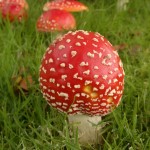
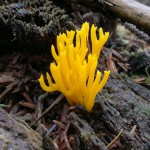
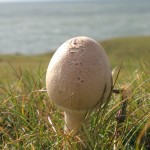
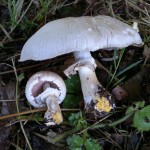
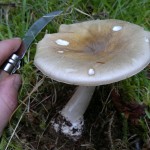
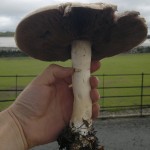
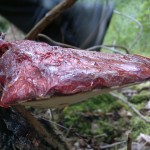

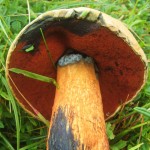
8 Comments
So far your words are the best I have found as a guide for distinguishing between mushrooms you can eat and those you must not, in spite of a disappointing lack of more particular pointers. I suppose, as you say, I shall have to find a qualified guide. Thank you for the helpful pictures.
Thanks John.
Thanks. If you explore this site more widely, you will find a wealth of more specific information! Try looking at the Wild Fungi Guide.
Mark
Thanks for your explanation, I live in British Columbia Canada but love your explanation! My wife is a Lake Disrict gal and grew up with a father who rambled the fields and streams of the northwest .
I shaved bright yellow fastballs/mushrooms sprouting all over my lawn are they poisonous please.
Please see here:
Got a garden with lots of ” looking at waxcaps” things.
Would send images but can’t in a comeent so please reply with your email address.
Many Thanks
Dave
I consider ‘toadstools’ to be shelf fungus that grow on trees.
I guess that kind of helps to prove that the term is very loose and subjective. 🙂 (–